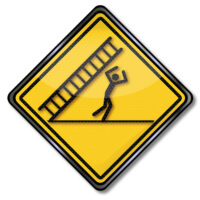Employer Succeeds in Having Injured Employee’s Scaffold Law Claim Dismissed

New York’s Scaffold Law imposes financial liability on employers who do not provide safe conditions or safety equipment to employees injured while working at a height on New York construction sites. While the law has been applied to a broad array of injury types and job sites, plaintiffs filing claims under Labor Law § 240 (1) must be able to support their argument to the court that the injury was related to work done at an elevation before the law will apply. A recent decision by the New York Supreme Court of Suffolk County found that an employee was not entitled to compensation under the Scaffold Law where he failed to show that his injury related to a task done at elevation. The case was titled Laxton v. New York Racing Association.
Edward Laxton, the injured worker, received injuries to his ankle while removing a 16-foot stair pan (the structural steel tread and riser on a staircase) at the Resorts World Casino at the Aqueduct Racetrack. Laxton and a coworker, Michael Owen, were ironworkers installing a pre-fabricated staircase at the casino. The men needed to remove an excess stair pan that the manufacturers had accidentally included in the staircase. After cutting the welds that held the stair pan between the stringers, the men needed to remove the pan from between the stringers before it could be lowered to the ground, four feet below them. The men lost control of the stair pan, which sprung out of the stringers, bounced on the ground, and hit Laxton in the ankle. Laxton filed a claim for damages against Tutor Perini Corporation, the company that contracted with his employer to install the stairs, as well as casino owners Genting New York. Laxton claimed that the defendants had violated § 240 (1) by failing to provide the men with a hoist, forklift or blocks to stabilize the 200-lb stair pan as they lowered it to the ground, which he claimed were necessary pieces of safety equipment for the job.
Laxton filed a motion for summary judgment to find the defendants liable under this law. Laxton presented testimony from an expert in engineering asserting that hoists or blocking materials would have been necessary safety equipment. He also included testimony from a fellow employee stating that the defendants had not provided any equipment to Laxton for the purpose of removing the stair pan.
The defendants filed a motion to dismiss Laxton’s claims entirely. The defendants presented testimony from their own expert, stating that two men should have been able to remove the stair pan without additional tools, and that if the stair pan popped out of the stringers violently, it was likely due to the men failing to properly control the stair pan. Finally, the defendants argued that none of the extraordinary risks of work done at an elevation applied to Laxton’s claims. The court agreed with the defendants, ruling that Laxton “was exposed to the usual and ordinary dangers of a construction site, and not the extraordinary elevationrelated risks envisioned by Labor Law § 240 (1).”
Laxton had also claimed in his lawsuit that the defendants had violated Labor Law § 200, which provides damages to injured workers where an employer who controlled the method and manner of work was negligent. The court concluded that the defendants did not control the manner in which Laxton did his work, and dismissed that claim. Finally, Laxton’s claim for damages under Labor Law § 241(6) was also dismissed. This law provides money damages where an injured worker can show that an employer had committed a violation of a rule or regulation included in the New York Industrial Code. The judge’s opinion listed all 14 sections of the Industrial Code that Laxton had included in his complaint, describing each section and explaining why each one did not apply to Laxton’s claims.
If you’ve been injured on the job in New York, be sure to seek legal help from an experienced, trial-ready, and effective New York construction accident attorney, and contact Manhattan personal injury lawyer Leandros A. Vrionedes for a consultation at 212-889-9362, with additional offices in Queens at 718-777-5895.


